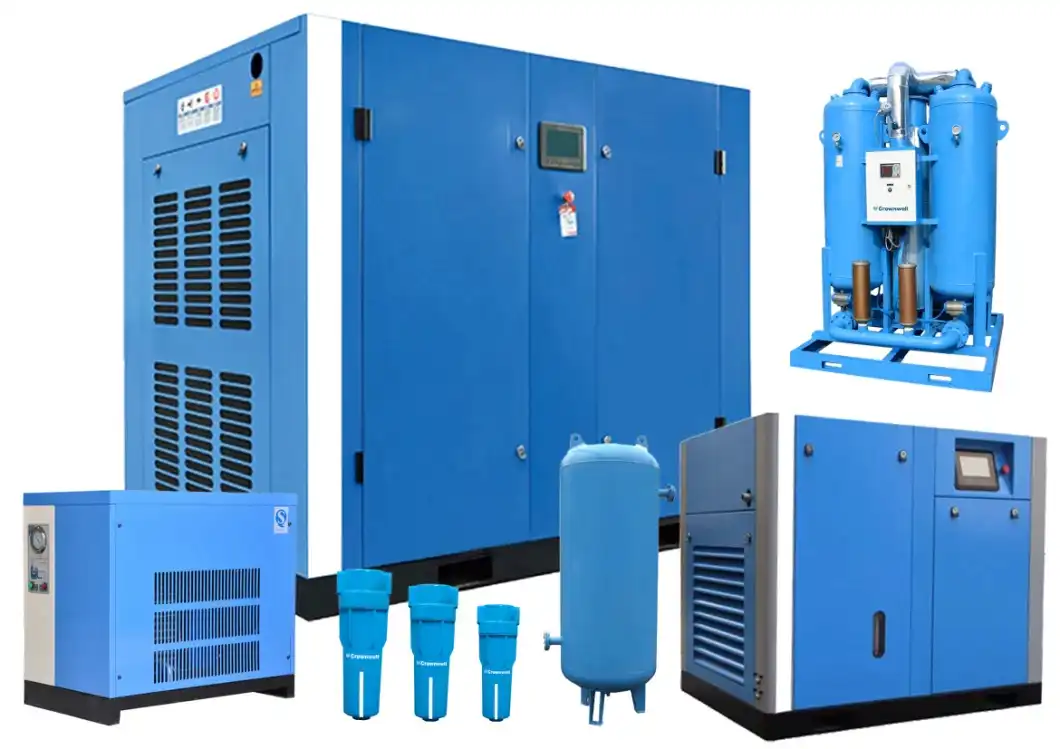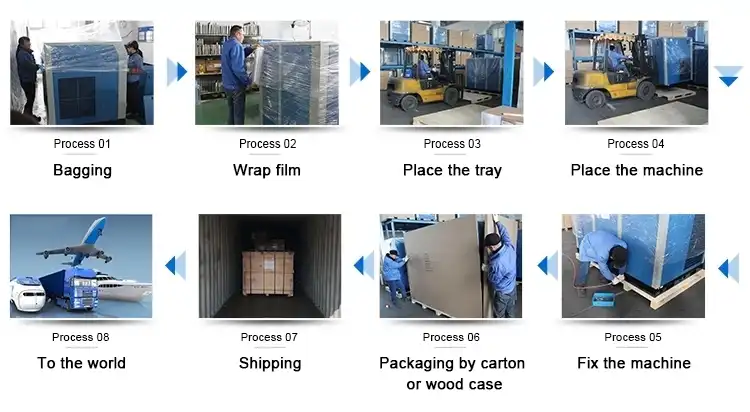Product Description
Quick Details
| Applicable Industries:
Building Material Shops, Manufacturing Plant, Machinery Repair Shops, Food & Beverage Factory, Construction works , Energy & Mining, Other
|
Customized support:
OEM, ODM
|
| Part name :SPA SPB cast iron pilot bore 3 grooves timing belt pulley | Surface treatment: Blackened/blue |
| Material: C45 | Brand Name:REACHJY |
| Application:power transmission | Inspection: 100% |
| Certification:ISO | Place of Origin:Sichuan, China |
| Applicable Industries:
Building Material Shops, Manufacturing Plant, Machinery Repair Shops, Food & Beverage Factory, Construction works , Energy & Mining, Other
|
Customized support:
OEM, ODM
|
| Part name :SPA SPB cast iron pilot bore 3 grooves timing belt pulley | Surface treatment: Blackened/blue |
| Material: C45 | Brand Name:REACHJY |
| Application:power transmission | Inspection: 100% |
| Certification:ISO | Place of Origin:Sichuan, China |
A Buyer's Guide to Air Compressor Types
There are many types of Air Compressors, and it's important to understand what each type has to offer. In this article, we'll discuss single stage air compressors, low-noise compressors, and models with two pistons. But, before you buy an Air Compressor, be sure to read our buyer's guide to the various types. This way, you'll have all of the information you need to make the right decision for your business.
Single-stage air compressors
A single-stage air compressor is an excellent choice for most general-purpose purposes. They provide enough power to operate pneumatic tools, and they produce less heat. Single-stage air compressors, however, are not suitable for heavy-duty industrial uses. However, they can be used in various applications, including auto shops, gas stations, and various manufacturing facilities. They are also suitable for borewells and other high-pressure places.
These air compressors are a great choice for home use and are suitable for small-scale businesses, contractors, and small shops. These compressors have continuous duty cycles, cast iron compressor pumps, and a minimum 5,000-hour pump life. They also feature advanced features, including ODP motors, Auto Start & Controls, Receiver tanks, and power cords. They have low maintenance and can save you a great deal of money.
Single-stage air compressors are generally less expensive and lighter than their two-stage counterparts. Single-stage air compressors are also more portable, which is a plus for small projects. While two-stage compressors offer higher CFM, they are more powerful and bulky, making them unsuitable for small or home use. So it is essential to determine what you will use the air compressor for and decide on a model based on your needs.
A single-stage air compressor is made of a piston and a tank. The piston moves rapidly inside the cylinder and exerts pressure on the cylinder. This means that the piston can't move any faster than the air pressure outside the cylinder. The piston is designed to operate in the same way for each stage. This is a great choice for home shops and one-man automotive shops, as it allows you to control the pressure without sacrificing the pump's life.
Single-stage air compressors are often cheaper than two-stage versions, but they are not the best choice for every application. If you are only using your air compressor occasionally, you'll find a one-stage model to be much more reliable than a two-stage model. The main difference between the two types of compressors is in the amount of air that each stage compresses. A two-stage air compressor will have more air storage capacity, but it will still produce more pressure.
Rotary vane compressors
Rotary vane compressors use a centrifugal pump to compress air. The rotor is set eccentrically in the housing, which almost touches the vane. As the rotor turns, the air that enters the pump is trapped between the vanes. This compressed air undergoes compression as the rotor rotates. Vanes are small pieces of carbon fiber or graphite composite. Vanes may be made of different materials depending on the application.
While rotary vane pumps are not commonly used to produce compressed air, they are widely used in automotive and hydraulic applications. Chances are, you have used a rotary vane pump at some point in your life. These pumps are also common in the vacuum and compressed air industries. As a result, many people don't realize that they're still around. They feature slots that allow the vanes to slide in and out of the rotor.
A rotary vane compressor has a drum and rotor inside. The rotor is eccentrically positioned and has slots and grooves on its surface. Its inlet and outlet ports are situated off-center, allowing the vanes to be pushed out by centrifugal force. Because the rotor rotates so quickly, air is trapped between the vanes. This air then becomes pressurized by the rotating rotor.
Rotating vane compressors can be easily serviced and repaired. A simple replacement of carbon vanes requires just 15 minutes and common tools. The carbon vanes typically last nine to eighteen months, depending on system operating pressure. Before purchasing a rotary vane compressor, make sure to check whether it has been properly performance-tested and has a warranty. Generally, warranties cover the rotor/stator chambers but do not cover the vanes or air filters. You should also check if the unit is covered by a lightning or water damage warranty.
Rotary vane compressors are an integral part of manufacturing industries. Many pharmaceutical manufacturing facilities depend on rotary vane compressors to control their equipment. Other industries that use rotary vane compressors include the plastics, woodworking, natural gas, and medical & dental fields. Their benefits are numerous and far outweigh any disadvantages of rotary screw compressors. For example, a rotary vane compressor can double the life of a conventional compressor.
Rotary vane compressors with low-noise models
If you are looking for a rotary vane air compressor, you have come to the right place. CZPT's LV Series rotary vane compressors offer low-noise models, compact size, and robust integration. In addition to their low-noise features, they feature large filter systems to deliver high-quality compressed air. The LV Series models also feature CZPT's reputation for reliability and quality.
This type of compressor uses centrifugal force to operate and is limited in its top and minimum operating speeds. They are only a third as powerful as screw compressors, and their top speed limits are much lower. Furthermore, the vanes wear out easily at high speeds because there is not enough centrifugal force to seal them against the cylinder's edges. Even at half their full capacity, they consume as much as 80% of their total energy rating.
Because piston compressors produce a lot of noise, factory owners and shop owners have begun to install noise-dampening cabinets and other solutions. But, rotary vane compressors produce far less noise than a traditional vacuum, and the maintenance costs are also low. Rotary vane compressors are also extremely helpful in several industries. They are used in the automotive and auto finishing industries, as well as in dairy industries and milking machines.
If you have a deep pond, a rotary vane air compressor kit can pump up to 20 feet of water. This is more than enough airflow for two to five diffusers. A 1/4 HP rotary vane kit pumps around 4.2 CFM. It also helps to increase circulation and oxygen levels in the pond. Finally, a 1/4 HP kit offers the necessary power to clean up the bottom of a pond.
The rotary vane and rotary screw are the most popular air compressors today. While they are similar in many ways, they are more versatile and durable than their counterparts. They use fewer angular contact ball bearings and require less frequent maintenance than piston air compressors. Compared to piston air compressors, rotary vane and rotary screw compressors are quieter and are less expensive.
Rotary vane compressors with two pistons
The rotary vane and rotary screw compressors are similar in application, but both have different advantages and disadvantages. This article will compare the benefits of each and highlight the differences between them. While both are commonly used in industrial applications, rotary vane compressors are preferred by many industries. These compressors also have a wide range of uses, ranging from automotive air tool operation to milking machines. These compressors also have the advantage of being quieter than piston-powered ones.
The current common rail position may not be suitable for pressure swirl injectors, but new positions have been tested and show improvements in specific energy values. Moreover, the current position is not required for external oil pumps. However, mass induction and expulsion have to be performed with utmost care. This article focuses on the design and efficiency of rotary vane compressors. You can find more information about this new design in the references mentioned below.
The advantages of this type of compressor are its low cost, compact size, and easy maintenance. Hence, they are preferred in low capacity applications. Moreover, they feature integrated vanes. The rotating vanes close the air gap and compress air towards the outlet. Compared to piston-powered compressors, these units are cheaper and more reliable. Therefore, you should choose one with the lowest price tag. You can also opt for rotary vane compressors that are oil-free.
Sliding vane compressors are another popular variant. They have a single cylinder connected to the compressor and are capable of operating at low speeds. This design also reduces the amount of friction and maintains volumetric efficiency. However, the sliding vane compressors suffer from high frictional losses. If you are looking for a more efficient rotary compressor, this is the best option. While sliding vane compressors have been in the spotlight for over a century, they are still quite young.
These compressors are easy to install and maintain. They are also quieter than piston compressors. They are also cheaper than piston-driven compressors. The energy efficiency and low price make them the perfect choice for any commercial or industrial application. If you're looking for a small, compact compressor, the rotary vane has been proven to be the best choice for your needs. You should know that it has a long service life.

